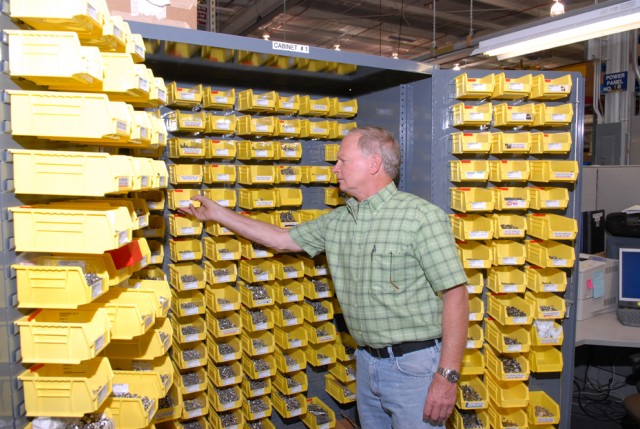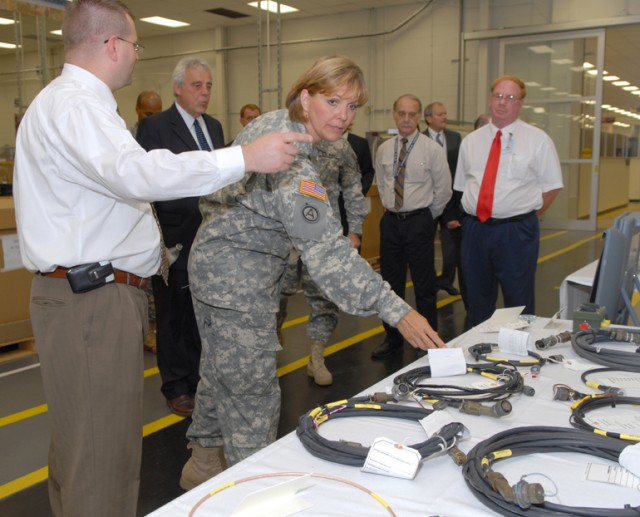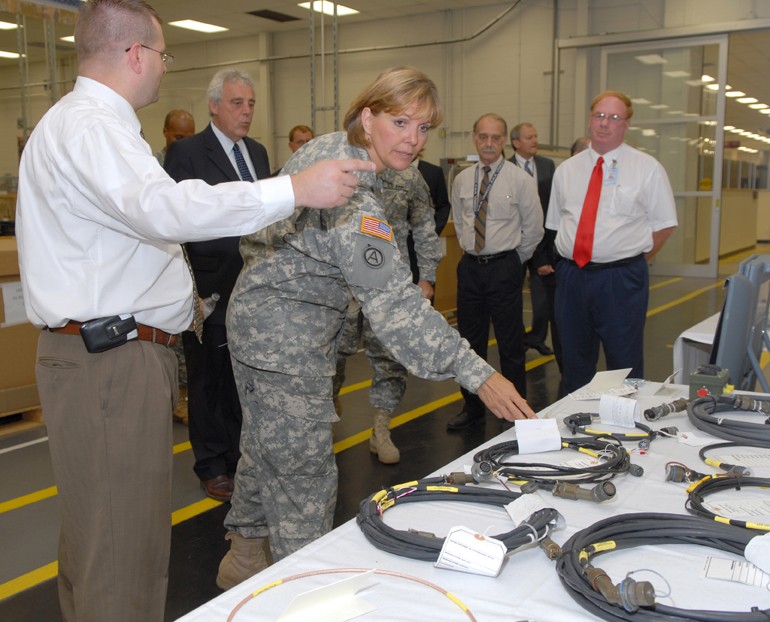TOBYHANNA ARMY DEPOT, Pa. - A new process for storing high volume, low cost parts will streamline how Tobyhanna employees perform their jobs - saving time and money.
Personnel in the Production Management Directorate's Materiel Management Division will oversee the Industrial Product-Support Vendor (IPV) program, which charges a local vendor to monitor and replenish 7,000 storage bins positioned throughout the depot. The vendor will maintain stock levels for 3,327 IPV parts such as nuts, bolts, washers and resistors.
Defense Supply Center Columbus (DSCC) has partnered with Agility Defense & Government Services (DGS) to monitor, replenish and report consumption on Tobyhanna's IPV bins. To kick off the initiative, depot, DSCC, Defense Distribution Tobyhanna (DDTP), Defense Distribution Center and Agility officials participated in a ribbon-cutting ceremony July 2.
DSCC manages 2.1 million items and supports more than 145,000 customers throughout the military services, civil agencies and other Department of Defense organizations. DSCC awards over 707,000 contracts annually, supports nearly 1,400 weapon systems, and handles over 6.7 million orders on a yearly basis, with annual sales topping $3.5 billion.
Brig. Gen. Patricia E. McQuistion, DSCC commanding general, remarked that this "groundbreaking enterprise" will set the stage for Tobyhanna's future repair efforts.
"You're the best depot in the Defense Department today, and from what I saw today you are postured to remain there. You're thinking about not just what you're doing today, but what you're doing in the future."
IPV positions the depot for current production and is going to allow employees to do what they do best - turn wrenches, fix items and get them into the hands of the warfighter, she added.
"This program will put the parts where you need them, when you need them, as soon as you need them," McQuistion said. "This is a journey. We know we don't have it all right yet, but we're working daily to get it right for you."
Storing frequently used items on the shop floor puts materials where the worker needs them. Members of the IPV implementation team worked with employees to compile a list of high-volume, low-cost items to stock bins in several work areas. High volume is generated when several depot-wide shops use the same items.
"I think we're going to have the right part in the right place every time an employee needs it," said Mike Henry (, division chief, noting that the new program will help managers track stock "so employees can do their job and Tobyhanna can accomplish its mission."
A recent analysis indicated that using the IPV program would result in a cost savings by generating fewer requisitions and requiring less handling of materiel by receiving and storage activities. Earlier practices relied on employees submitting requests for IPV materials that would be delivered to the shops. IPV items, which cost $50 or less, have a minimum use rate of 100 per month. Costs are shared by all work centers.
"The IPV initiative was instituted to benefit the Tobyhanna work force, cut costs and save time while providing top-quality products to our customers," said James Antonelli, Production Management deputy director, noting that it's important for everyone to work together as the depot transitions to the new way of doing business.
Antonelli pointed out that a project of this magnitude takes time to execute. "It's a work in progress," he said. "Our main priority is to make sure needs are being met and questions are being answered." He added that employees at all levels are encouraged to share their ideas with the IPV team. Team members are ready to help workers adjust to the new initiative, he said. The hotline number is 895-9810.
"It is more productive to allow these materials to be managed with the IPV," said Robert Adams, acting chief of the Requisition Branch, adding that the practice frees up time and people by not having to process individual requests. "By putting the items at a point-of-use location, artisans can draw the parts they need themselves."
The IPV program will also cut down on storing excess stock, according to Michele Fairservice, supply system analyst in the Requisitioning Branch. "Employees don't need to keep an excessive amount of stock on their bench. They'll know the parts are always there in the quantities they need," she said, explaining that IPV items are placed in separate, unlocked cabinets.
IPV items account for about 10 percent of the Materiel Management Division's workload. The division manages materiel needed for the continuous, efficient and effective operation of the depot production processes. This includes management of, and ready access to, assets and parts, as well as required tools and Test, Measurement and Diagnostic Equipment. The division consists of requisitioning, materiel planning, tool crib, materiel movement, receiving, mission materiel staging, materiel expeditors, Hazmat pharmacies, wire cutting area, inventory management and operation of the off-line accounts.
"Once we see who is using what and how often based on the data in LMP, we can plan much better for their future needs," Henry said, noting that about $22 million worth of items have been updated so far.
The IPV parts list is far from complete, according to Fairservice. She stated that if an employee needs something that isn't on the list, the item can be added. Shop leaders or supervisors need only provide the IPV cell with the following information: National Stock Number (NSN) or manufacturer's part number with a cage code and how often the part is used.
"We're looking for input from the shops to name common hardware items. We've crosschecked the existing Schedule of Supply list and added 865 items," said Fairservice. "During the process we also realized several obsolete items that could be deleted from the schedule."
To help Agility provide the best service possible, employees are reminded to stop movement of the cabinets, drawers and bins containing IPV materials. The contractor has mapped the entire depot to show the exact location of all storage bins. Labels have been printed with the tool's NSN, part number, nomenclature, etc. to include the exact location of the bin.
"When [a technician] takes the bin, the vendor can't replenish the parts," said Fairservice. She also mentioned that items pulled from the bin and not used can be placed in return bins [marked with red labels]. "Workers don't have to worry about putting things back in the right place; Agility will do that for us."
There will be six or seven vendor employees at the depot at all times, according to Fairservice. The contractor is using government-furnished space to store a ready supply of parts. They also have a warehouse in Olyphant.
"The IPV program is a step in the right direction," Adams said. "The key is to make sure the [technician] has those parts when they need them-right time, right place."
Fairservice agrees. "This is only the beginning. We have a lot of room to grow."
Tobyhanna Army Depot is the Defense Department's largest center for the repair, overhaul and fabrication of a wide variety of electronics systems and components, from tactical field radios to the ground terminals for the defense satellite communications network. Tobyhanna's missions support all branches of the Armed Forces.
About 5,600 personnel are employed at Tobyhanna, which is located in the Pocono Mountains of northeastern Pennsylvania.
Tobyhanna Army Depot is part of the U.S. Army CECOM Life Cycle Management Command. Headquartered at Fort Monmouth, N.J., the command's mission is to research, develop, acquire, field and sustain communications, command, control computer, intelligence, electronic warfare and sensors capabilities for the Armed Forces.




Social Sharing